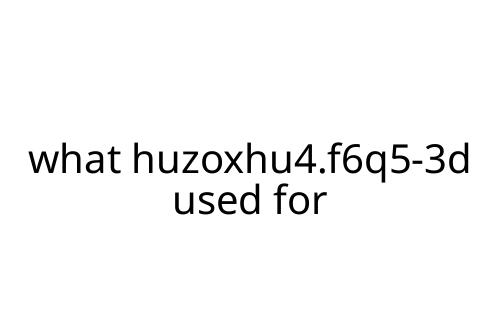what huzoxhu4.f6q5-3d used for
When searching for technical solutions or looking up unique codes, you might come across something like "huzoxhu4.f6q5-3d." The name itself doesn’t give much away. So, what is huzoxhu4.f6q5-3d used for, and why does it show up in systems or tech conversations? Let’s break it down.
Possible Contexts for huzoxhu4.f6q5-3d
“Huzoxhu4.f6q5-3d” resembles a system-generated identifier or code. In practice, codes like this pop up in several places:
- Software Debugging: Sometimes, development teams use autogenerated codes for error tracking. These codes help them pinpoint what went wrong in a complex program—acting as unique tickets in a log.
- Cloud or Database Access: In cloud platforms or remote databases, you’ll find similar identifiers tied to access tokens, user sessions, or resource IDs. They uniquely reference a dataset, file, or instance.
- Networking and Devices: Unique strings like huzoxhu4.f6q5-3d may also act as device IDs, network node references, or links to configuration profiles.
- Security and Authentication: Some platforms use randomly generated strings for multi-factor authentication tokens, passwords, or time-limited access codes.
How Is huzoxhu4.f6q5-3d Assigned?
Most frequently, such codes are automatically generated by software. Why? Because automation prevents duplication, ensures uniqueness, and removes human error. Generating a code like huzoxhu4.f6q5-3d gives the system an efficient way to track or reference resources internally.
Some systems allow users or admins to see these codes—for example, when reporting issues, sharing access, or configuring advanced features.
Pros of Using Unique Codes Like huzoxhu4.f6q5-3d
- Uniqueness: Keeps records separate and avoids overlap.
- Security: Harder for outside parties to guess or fabricate access.
- Organization: Makes tracking resources or issues scalable in larger systems.
Cons or Challenges
- Readability: Human users can’t guess the purpose from the code itself. This may require documentation or reference tables.
- Loss or Confusion: If miscommunicated, you might access the wrong record or device.
- Dependency on Systems: If the generator fails or duplicates a code by mistake, it may cause rare but significant errors.
Practical Tips
- If you encounter "huzoxhu4.f6q5-3d" and you’re unsure what to do, check the context—are you working with an app, a data report, or configuring a network?
- Keep a record of where you find or use unique codes. Documentation helps track their purpose.
- When reporting issues or seeking support, provide the exact code (like huzoxhu4.f6q5-3d) for faster troubleshooting.
In Summary
So, what is huzoxhu4.f6q5-3d used for? Most likely, it serves as a unique, system-generated identifier in software, databases, networks, or authentication systems. It keeps things organized, secure, and manageable. The specific use depends on the context—if you see this code, treat it as a key to tracking or referencing something important within a technical environment. Always keep context and documentation handy to avoid confusion.


